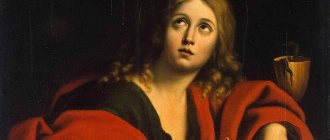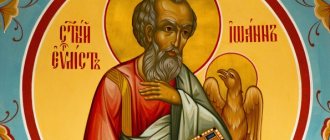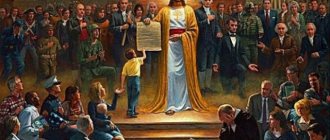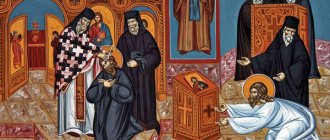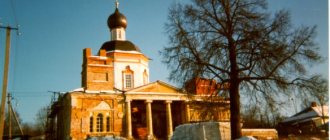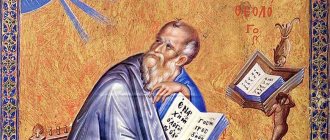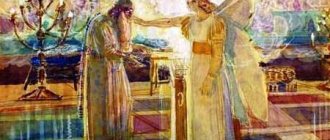One day Gregory was in prayer in the desert. Then two people approached him - an old man and a luminous Woman. At the word of the Wife, her companion taught Gregory the Creed. Since ancient times, the term “Woman” here has meant the Most Holy Theotokos Herself, together with the elder Apostle John the Theologian. What the Apostle John conveyed to Gregory, he then wrote with his own hand.
Saint Gregory the Wonderworker is the first Neocaesarea bishop, as well as a saint and theologian. His memorial day is celebrated on November 17th.
Saint Gregory the Wonderworker - one of the descendants of Greek settlers
Gregory the Wonderworker was born into a famous and wealthy family
Gregory the Wonderworker was born into a famous and wealthy family. He became one of the descendants of the Greek settlers. His exact date of birth is unknown. It is believed that the future Bishop of Neocaesarea was born around 213 in Neocaesarea. At first his name was Fedor, and then at baptism he received the name Gregory.
Gregory's father was far from Orthodoxy, which is why he raised his son as a pagan. Since he was not poor at all, he wants to give his son a good secular education. At the age of 14, Gregory's father died, and everything began to depend on his loved ones.
For some time Gregory studied at the school of grammar and rhetoric. He wanted to become a lawyer, studied law and laws
For some time, the wonderworker Gregory of Neocaesarea studied at the grammar school, then at the rhetorician school. After which he became deeply involved in law.
He was preparing to become a lawyer, studied laws and law for a long time and diligently. In order to master Roman law at least a little, he planned to go to Rome. But the Lord decreed otherwise.
One day, together with his brother Athenodorus, he went to Caesarea, where he met a teacher of Christians
One day, Gregory, together with his brother Athenodorus, accompanied his sister to Caesarea, where he had the opportunity to continue his education in Beritus. There was a pretty famous law school there at the time. At that time there was also a theological school there, which was built with the support of the Christian teacher Origen.
Origen - Greek Christian theologian, philosopher, scientist. Gregory and his brother became his students
Then Gregory and his brother decided to go to one of the sermons. It still remains unclear whether they went there purposefully, or simply out of ordinary curiosity. In Caesarea, Gregory received the Sacrament of Baptism.
Soon Gregory personally met with Origen. Then their acquaintance grew into friendship. Origen invited Gregory to be his student. Gregory was followed by his brother. Origen consistently revealed to them the meaning of the Holy Scriptures and Christian teachings. After training, Gregory received Baptism. Then, together with their brother, they returned to their native lands.
Proceedings
The saint's writings had a significant influence on the theology of the Orthodox Church, especially in the doctrine of the Most Holy Trinity. But not many of the saint’s works themselves have survived, due to the fact that there were times of persecution and some of them simply perished.
Several can be called genuine:
- the saint retained warm feelings for his teacher until the end of his life and dedicated to him a “Laudatory in honor of Origen”;
- The “Exposition of Faith” also became significant, containing all the main thoughts of the future Nicene-Constantinopolitan Creed; in accepting it, the fathers of the Council were guided, in many ways, by this work of Gregory;
- “Canonical Epistle” addressed to the Christians of Pontus who were invaded by barbarians;
- "Transposition of Ecclesiastes" is the first interpretation of this unusual book of the Old Testament in the Christian tradition.
Here is what can be called the authentic creations of St. Gregory of Neocaesarea himself. But there were also quite a few manuscripts that were attributed to this saint. Of these, only the following works had authority in the Orthodox world, and were considered authentic:
- Epistle “To Evagrius the monk about the Divinity”;
- “A short word about the soul to Tatian”
And although it has been proven that these works do not belong to Saint Gregory of Neocaesarea, they at least correspond to the true views of the saint himself.
Important! There are works that are completely false, for example, “12 chapters on faith,” as well as 11 sermons on various occasions, in which genuine Orthodox teaching is distorted. In addition, the saint is credited with composing several spellless prayers that are used in the rite of exorcism. They are included in the breviary of Metropolitan Peter of Kyiv Mohyla.
All this indicates that the name of the saint was so popular that heretics also tried to use it to justify their incorrect views.
In 245, Saint Gregory was ordained Bishop of Neocaesarea
Returning to his city, Saint Gregory decided to retire from all the bustle of the world; he decided to devote himself to serving God. In 245 he was ordained Bishop of Neocaesarea. At first, Gregory did not want to take it upon himself, he refused and left. But Bishop Fedim still imposed control of the city on him.
When Gregory found out about this, he was greatly amazed. He could not resist this, since the Lord Himself pointed him to this place. After this, Gregory was ordained a bishop.
Saint Gregory of Neocaesarea became bishop of Neocaesarea in 245 when he returned from Caesarea
At the beginning of his ministry, there were only a few believers in the city, and by the end, only a few lost souls were discovered. The fame of Gregory gradually spread throughout the world. Later the holy fathers began to call him Great and Famous.
In the 5th century, the word Wonderworker was also added to his name, since during his lifetime he was awarded the gift of miracles by God. He performed miracles in the name of Christ. He healed the sick and lame. During the persecution of Christians, the saint hid from the pagans with his flock.
In 264, Gregory took part in the Antioch Local Council against Paul of Samosata, who spread the false teaching about the Holy Trinity.
A mistake that costs eternity
This is the most enduring of Origen’s false intuitions condemned by the Church. Indeed, is there at least one person who would like to suffer forever? In our souls lives an ineradicable desire not only not to disappear, not to perish, but also to fulfill our original destiny - communion with God. And therefore: “Honor to the madman who will bring a golden dream to humanity!” The temptation is very great to come up with a system that removes the problem of eternal torment.
But what then is the responsibility for personal life choices? What does the Church say? Eternal salvation is the point at which two mutually directed vectors meet: God’s mercy and man’s desire for God. None of the people will ascend to Heaven on their own, but God’s mercy in itself will not save a person if he does not strive for it. Of course, this creates anxiety, because we do not know our future fate. But the Church condemned Origen’s error not in order to rejoice in the future eternal retribution for sinners, but so that we would see in time the true state of affairs and stop wasting the time allotted to us. This is the harsh truth. But it is better than a tempting lie.
Some argue that Origen expressed all these ideas solely for missionary purposes, in order to be clearer to the Hellenic environment. And the Church, they say, condemned only his false assumptions. And Origen himself, in his work “On the Beginnings,” seems to warn: “We rather offered the reader thoughts for discussion than gave a positive and definite teaching.”
Fathers of the Fifth Ecumenical Council
But the Church nevertheless condemned both the works of Origen and himself.
It all started with the edict of Emperor Justinian the Great and the definition of the Local Council of Constantinople in 543, which declared: “Whoever says or thinks that the punishment of demons and wicked people is temporary and that after some time it will have an end, or that there will be a restoration of demons and wicked people after a while, - let him be anathema." Nine years later, the condemnation of Origen was confirmed by the fathers of the Fifth Ecumenical Council. And then the Sixth.
The trouble is that heresy is not just a mistake or delusion into which a person falls out of ignorance or due to an incorrect conclusion. And if according to the Hamburg account, then dogmatics is not the theoretical abstractions of the scholastics, it is the path to salvation. And theological errors inevitably lead many people who believe in authority into a dead end. But the Gospel says: by your words you will be justified, and by your words you will be condemned (Matthew 12:37).
It is believed that Gregory died between 270 and 275.
The exact date of Gregory's death is unknown. Presumably it is believed that he died between 270 and 275 years.
Fragments of the works of St. Gregory the Wonderworker on the website azbyka.ru
Gregory had a huge number of written teachings. Unfortunately, not much has survived to this day. His creation, the Symbol of Faith, occupies a huge place. The Creed also has a brief summary, which Gregory received even before his elevation to the see of Neocaesarea.
One day he was in prayer in the desert. Then two people approached him - an old man and a luminous Woman.
At the word of the Wife, her companion taught Gregory the Creed. Since ancient times, the term “Woman” here has meant the Most Holy Theotokos Herself, together with Elder John the Theologian. The Apostle John is also known in the Russian Orthodox Church.
Saint Gregory once met John the Theologian, who gave him the Creed of the Christian Faith
This is what John conveyed to Gregory, which he then wrote in his own hand:
“One God, Father of the Living Word, Hypostatic Wisdom, Power and Image of the Eternal, Perfect Parent of the Perfect, Father of the Only Begotten Son. One Lord, One from One, God from God, Image and Image of the Divine, the Word active, Wisdom, which embraces the composition of everything that exists, and the creative Power of all creation, the True Son of the True Father, the Invisible, Imperishable, Immortal and Ever-Everlasting Son of the Invisible, Incorruptible and Ever-Everlasting. Father.
And there is one Holy Spirit, who has his being from the Father and is revealed to people through the Son, the Perfect Image of the Perfect Son, Life, the Cause of all living things, the Holy Source, the Holy Place that bestows sanctification, in whom God the Father reveals Himself, Who is above all and in all, and God the Son, who through all, is a perfect Trinity, with glory, eternity and kingdom, indivisible and inalienable.
So, in the Trinity there is nothing created, or auxiliary, or introduced, as if it had not previously existed, but has subsequently arrived. So, the Son lacked nothing before the Father and the Holy Spirit before the Son, but the same Trinity is always unchangeable and unchangeable.”
“Exposition of Faith” by Gregory the Wonderworker on the website azbyka.ru
Relics
After the saint reposed, his relics were in the temple that he himself built during his life in Neocaesarea. But later the fate of the relics of Gregory of Neocaesarea developed as follows:
- the right hand of the saint resides in Jerusalem in the Church of the Holy Sepulcher;
- the left hand is located in the Meteora Monastery;
- the head resides in the Church of San Roque in Lisbon, the capital of Portugal.
And it turns out that other parts of the body of St. Gregory were, to one degree or another, scattered throughout many Orthodox and Catholic churches of the world. They are in the Panteleimon Russian Monastery on Mount Athos, in the Church of St. Anastasia in Athens, in the monastery of St. John the Theologian on the island of Patmos, in the Monastery of the Assumption of the Virgin Mary in the Peloponnese, in the Church of St. Peter in Rome. And also in the church on Bolshaya Polyanka in Moscow, which was consecrated in honor of Gregory of Neocaesarea, this is where you can venerate his holy relics.
Gregory of Nyssa also wrote a word about the life of St. Gregory the Wonderworker
It is also worth mentioning that Gregory of Nyssa had one of his wonderful creations, which is called “The Sermon on the Life of St. Gregory the Wonderworker.”
“A Sermon on the Life of Saint Gregory the Wonderworker” by Gregory of Nyssa on the website azbyka.ru
Gregory of Nyssa is a Christian theologian and philosopher, as well as the bishop of the city of Nyssa. This is one of the three great Cappadocians. Gregory of Nyssa is the younger brother of Basil the Great, a close friend of Gregory the Theologian. He was also a member of this Cappadocian circle.
Three great Cappadocians of the Russian Orthodox Church - Gregory of Nyssa, Basil the Great, John Chrysostom
Miracles through prayers
There are countless miracles through the prayers of St. Gregory of Neocaesarea; we can only point out a few of the most famous:
- Two brothers could not divide the lake between themselves and turned to the saint for help, he agreed to help and prayed all night about this matter, in the morning everyone saw that there was no subject of contention, since the lake had dried up;
- also through the prayers of St. Gregory of Neocaesarea, during his journey to Amasia, a demon was expelled from the idolatrous temple of the city, and a temple was built on the site of the temple, and through the prayers of the saint a whole block of stone was moved so that a temple could be built in a free place.
During the persecution of Decius, the emperor's soldiers pursued Christians led by Saint Gregory, Bishop of Neocaesarea, up to a high hill, where the saint took refuge with his supporters and offered prayers to God, after which the Christians became invisible to their enemies and were saved.
The miraculous power of the saint, his participation in God's providence was so great that everyone, of course, obeyed his will, and even people of such a level as Basil the Great recognized his unconditional authority.
An icon was painted to Gregory the Wonderworker
An icon was painted to Gregory the Wonderworker. The earliest images of it were found on the frescoes of the Cathedral of St. Sophia of Constantinople. On the icon, Saint Gregory is depicted from the waist up or to his full height. He holds the Holy Gospel with both hands. They say that an original icon painting of St. Gregory currently exists.
This is what a more modern icon of Gregory the Wonderworker looks like
Reverence
The saint died long before the Christian empire emerged, centered in Constantinople, but on its territory. And the amazing life of Gregory the Wonderworker Bishop of Neocaesarea made him a person who was revered in all parts of the empire precisely as a wonderworker and a stronghold of Orthodoxy.
- In the Church of St. Sophia in Constantinople there was a column with an icon of St. Gregory the Wonderworker, in memory of his appearance in this place, this place was especially revered.
- Nowadays, when Constantinople has become Istanbul, there is no image of the saint on this column, but from time to time moisture appears on it, which is considered by the Orthodox to be the tears of the saint for all the desecration of the Orthodox by Muslims.
- In Rus', the prayerful veneration of the saint began in a very early period; the first services to him were translated into the Slavic language even before the first translations of the life appeared, i.e. in the second half of the 11th century, while lists of written lives were available only in the 12th century, this suggests that there was an oral tradition of retelling the life of the saint.
The first temple in Rus' in honor of the saint was built in the 17th century in Moscow. Well, in general, dedicating churches to this saint has not become a tradition for Russia, although the saint himself was very revered, as evidenced by the iconography, which is of ancient origin. For example, in the Church of the Dormition of the Blessed Virgin Mary on Volotovo Field, the saint is depicted wearing an omophorion and holding the Gospel in his hands.
On a note! In the West, the Holy Wonderworker is especially revered in southern Italy, where in Calabria there is a large particle of the relics of St. Gregory the Wonderworker in the church of the village of Staletti.
Troparion and kontakion written to Gregory the Wonderworker
The troparion and kontakion were written to Gregory the Wonderworker. They are performed during his day of celebration in the temple.
You can always address the saint in your simple words. The most important thing is that your requests come from the heart.
Troparion to Saint Gregory the Wonderworker, Bishop of Neocaesarea, tone 8:
In vigilant prayers, enduring miracles by doing, you have gained the title of correction, but pray to Christ God, Father Gregory, to enlighten our souls, lest we fall asleep into death.
Kontakion to the Saint, Bishop of Neocaesarea, tone 2:
You have received many miracles, you have terrified demons with terrible banners and driven away human illnesses, Gregory of all wisdom, who is called a miracle worker, received the title from work.
Prayer to Saint Gregory, Bishop of Neocaesarea, Wonderworker:
O most honorable and sacred head and filled with the grace of the Holy Spirit, holy dwelling with the father, great bishop, our warm intercessor, Saint Gregory!
Standing at the throne of all the King and enjoying the light of the consubstantial Trinity and cherubically with the angels proclaiming the trisagion hymn, having great and unexplored boldness towards the all-merciful Master,
pray for the salvation of Christ's flock people, help our fatherland in battle, and subdue all the enemies that are against us, establish a peaceful and serene life for us:
establish the well-being of the holy churches: decorate the bishops with the splendor of holiness: strengthen the monastics to the feat of the good trend:
Please preserve this city and all our cities and countries, and keep the holy, immaculate faith: pacify the whole world through your intercession, deliver us from famine and destruction, and save us from the attacks of foreigners, comfort the old,
Instruct the young, make the foolish wise, have mercy on the widows, protect the orphans, grow up the babies, bring back the captives, heal the infirm, and everywhere warmly calling you and flowing to you with faith and diligently falling down and praying to you from all misfortunes and troubles through your intercession for freedom.
Pray for us to the all-generous and philanthropic Christ our God, so that on the day of his terrible coming he will deliver us from this evil state, and create the joys of the saints as partakers with all the saints forever and ever. Amen.
By leaving a comment, you accept the user agreement
